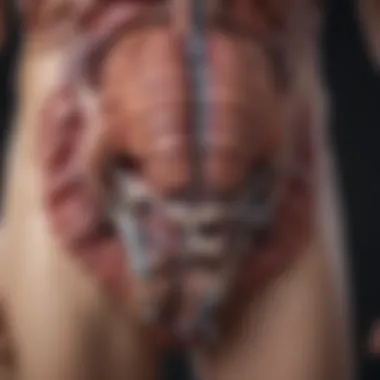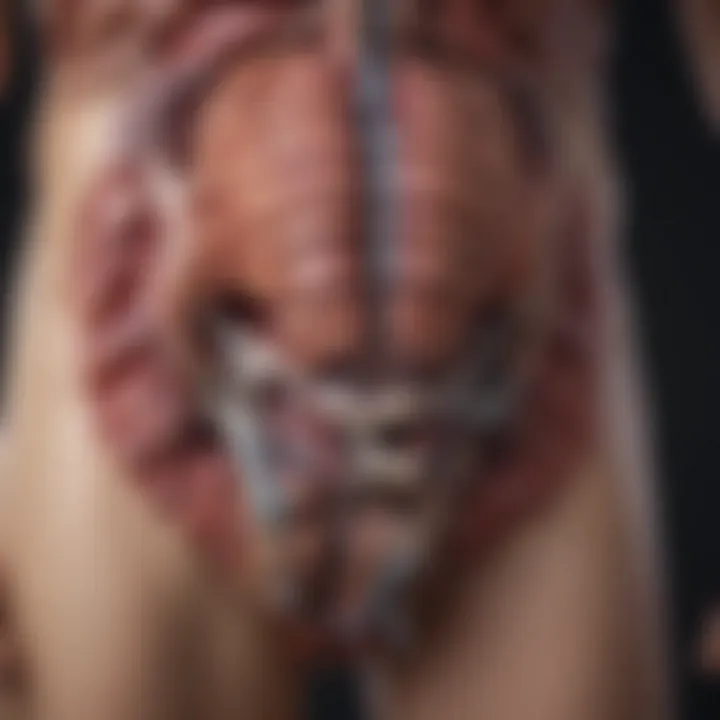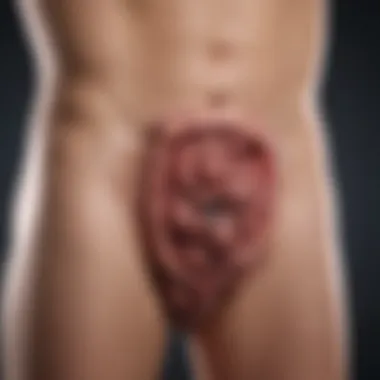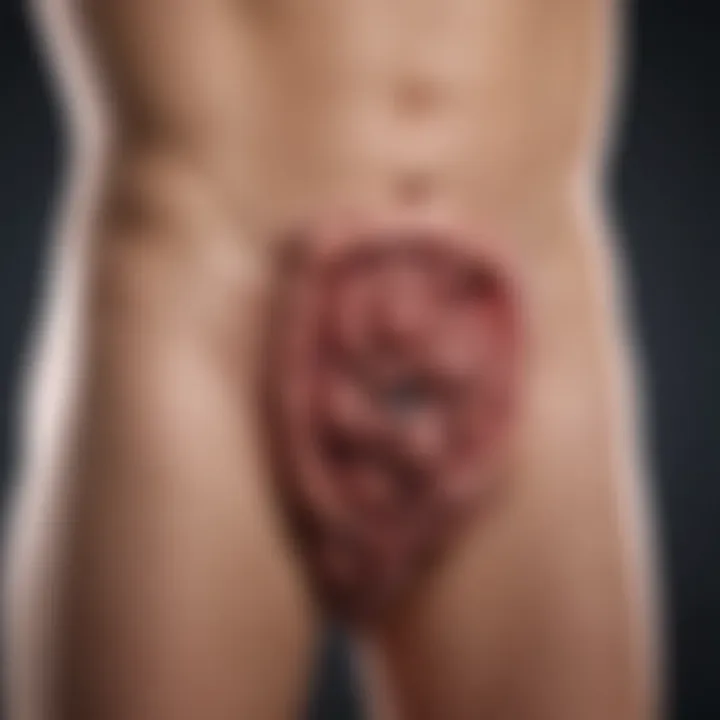Understanding Causes and Management of Rectal Pain


Intro
Sharp pain in the rectal area can be a distressing feeling that many individuals prefer to ignore or mask up with over-the-counter remedies. Yet, such pain often signals something deeper than mere discomfort. It's not just an inconvenience but can be a reflection of various underlying health issues. Gaining an understanding of what might be causing this sharp pain is crucial for effective management and treatment options. From benign causes to more sinister conditions, a thorough exploration of this symptom can illuminate the choices one makes regarding their health.
Key Concepts and Terminology
Definition of Key Terms
It's essential to clarify some terms often related to rectal pain. When discussing sharp pain, we refer to an acute, intense sensation that can differ from the dull ache often associated with other conditions. The rectal area is defined as the region encompassing the rectum and the anus, which are essential parts of the gastrointestinal system. Understanding these terms helps lay a solid foundation for further exploration of this topic.
Concepts Explored in the Article
This article delves into the anatomy involved in rectal pain, which includes:
- Anatomy of the Rectal Area: Brief anatomy overview, including muscles and nerves that contribute to sensations in this region.
- Common Causes of Sharp Pain: A look at benign conditions like hemorrhoids or anal fissures and serious considerations like abscesses or cancers.
- Diagnostic Approaches: Diagnostic tests and physical evaluations that healthcare providers might utilize.
- Treatment Options: Management strategies ranging from lifestyle modifications to medical interventions that aim to relieve pain and address the root causes.
Through understanding these concepts, individuals can better grasp the complexities related to acute pain in the rectal area.
Findings and Discussion
Main Findings
Research indicates that the spectrum of causes for rectal pain is extensive. Commonly reported conditions include:
- Hemorrhoids: Swollen veins in the lower rectum that can lead to sharp pain.
- Anal Fissures: Small tears that occur in the lining of the anus, often causing severe pain, especially during bowel movements.
- Abscesses: Pockets of infection near the rectum that result in throbbing or sharp pain and may require surgical intervention.
- Pelvic Inflammatory Disease (PID): In women, this infection can cause referred pain to the rectal area.
Recognizing these conditions aids in immediate response and timely medical intervention, ultimately reducing long-term consequences.
Potential Areas for Future Research
Further investigations could provide clarity in various areas related to rectal pain:
- The psychological impact of living with chronic rectal pain and its correlation with anxiety or depression.
- Long-term outcomes of non-invasive management strategies on quality of life.
- The role of diet and exercise in preventive measures against conditions causing rectal pain.
- Advancements in minimally invasive surgical techniques for severe cases.
These potential research avenues aim to enhance the current understanding of rectal pain and improve management strategies for patients.
"Knowledge is the starting point of all recovery. Understanding your symptoms is key to receiving help."
Arming oneself with information transforms uncertainty into empowerment, especially when facing sharp pain in the rectal area.
Prelims to Sharp Rectal Pain
Sharp pain in the rectal area can be more than just discomfort; it’s a signal from the body that something might be amiss. Understanding this pain is crucial for individuals experiencing it, healthcare providers, and researchers alike. It's an issue that impacts quality of life, making activities like sitting or even moving uncomfortable.
With the prevalence of such pain, it's key to delve into the various causes, be they trivial or serious. This article aims to provide a comprehensive overview, letting readers connect the dots between symptoms, potential diagnoses, and management options.
Defining the Rectal Area
The rectal area is part of the human anatomy that might not be discussed openly, yet it’s vital in understanding bodily functions. It extends from the end of the sigmoid colon to the anal canal, measuring around four to six inches in adults. This area serves critical roles, primarily in the waste elimination process. It consists of various layers of muscle, nerves, and mucous membranes that can be sensitive to numerous factors.
Knowing where the sharp pain originates is the first step toward addressing it. Discomfort can come from within the rectum itself, surrounding structures, or even referred pain from other organs. The complexity of this region makes it essential for individuals to communicate clearly about their symptoms with medical professionals.
Prevalence and Impact
Sharp rectal pain isn’t as rare as many might believe. Studies suggest that millions worldwide experience this kind of discomfort at some point in their lives. While some may brush it off, thinking it’s just a passing issue, the reality is that such pain can indicate underlying medical conditions that warrant attention.
The impact goes beyond physical sensations. Patients often face emotional distress and anxiety associated with their symptoms, fearing the worst.
"Taking care of our rectum is part of self-health; ignoring pain can have significant consequences in the long run.”
Often, discomfort in this area can interrupt daily life, affecting work, social interactions, and mental well-being. A thorough understanding of what causes such pain and ways to manage it can help lessen the burden on those suffering.
Anatomical Overview
Understanding anatomical components is pivotal when grappling with sharp pain in the rectal region. This detailed look helps paint a clearer picture of the potential reasons behind this distressing symptom. The rectal area is quite intricate, laden with various structures and systems that can influence pain perception, which in turn can lead to an array of medical conditions.
Key Structures Involved
The rectum itself is the final section of the large intestine, extending from the sigmoid colon to the anal canal. Its muscular wall is lined with a mucous membrane, providing elasticity to accommodate stool, and is surrounded by various structures that could be sources of pain, including:
- Anal sphincters: These are vital in maintaining continence and are composed of the internal and external anal sphincters. Dysfunction or irritation can lead to sharp pain.
- Nerves: The area is rich in nerve endings, particularly the inferior rectal nerve, which can be the culprit in conveying pain signals to the brain when stimulated.
- Vascular structures: Hemorrhoids, which are swollen veins in the rectal area, stem from these vascular components and can cause significant discomfort.
When one understands these key structures, it becomes evident how an issue in any of these can translate into severe pain or discomfort. The connection between these components and their role in not only normal physiology but also in pathological conditions is critical.
Nerve Pathways and Pain Perception
Pain perception is a sophisticated process, with nerves acting like a network of wires relaying signals to the brain. In the rectal area, the nerve pathways involved are mostly trigeminal, reflexive, and sensory nerves, each playing distinct roles:
- Local Nerve Endings: The local nerve endings in the rectal wall are the first to pick up any irregularities or injury. They are sensitive to pain and transmit these signals swiftly to inform the brain.
- Spinal Pathways: The signals then travel via spinal pathways that route through the lower lumbar spine. The complexity of this network means even a small inflammatory response can lead to heightened sensitivity and, consequently, sharp pain.
- Brain Interpretation: It’s crucial to note that how the brain interprets these signals can vary from one individual to the next. Factors such as emotional state, experiences with pain prior, or even psychological conditions can magnify the sensation of pain or modify the body’s response to it.
Understanding these pathways and their functionality is vital for recognizing the source of pain, aiding in the diagnosis and management of conditions associated with sharp discomfort in the rectal area.


"Knowledge of anatomy and nerve pathways empowers individuals to recognize warning signs, ensuring timely medical intervention is possible."
Through this understanding, professionals can better address the causes of rectal pain and provide effective treatment, ultimately improving the quality of life for those affected.
Common Causes of Sharp Rectal Pain
Sharp pain in the rectal area can be a significant source of discomfort and distress. Understanding the common causes of this pain is crucial not just for diagnosis but also for management strategies. Having a grasp of these common culprits allows individuals to explore treatments that are tailored to their specific conditions. Moreover, recognizing the sources of pain can lead one to appropriate medical advice in a timely manner, which is paramount to addressing underlying health issues.
Hemorrhoids
Hemorrhoids are swollen veins in the lower rectum and anus, a common source of sharp rectal pain for many individuals. The pain can spike during bowel movements, often coupled with itching or discomfort. Hemorrhoids can be internal or external; the external variety tends to cause more pain, particularly when sitting or straining. Treatment often involves dietary changes to soften stools, reducing straining during bowel movements, and in some cases, surgical intervention. Understanding hemorrhoids is essential as this condition can often be managed effectively with proper guidance and lifestyle adjustments.
Anal Fissures
Anal fissures are tiny tears in the lining of the anus. This can lead to severe pain during and after bowel movements. Many people find this type of sharp pain to be quite alarming, especially if it’s accompanied by rectal bleeding. The key characteristic of fissures is the sudden, intense pain that can make everyday activities uncomfortable. Treatment often comprises topical medications and dietary changes to ensure smoother bowel movements, which can be pivotal in healing the fissure.
Gastrointestinal Disorders
Irritable Bowel Syndrome
Irritable Bowel Syndrome (IBS) stands out due to its broad symptoms which extend beyond the rectal area. Individuals with IBS experience a range of issues including cramps, bloating, and erratic bowel habits. Notably, the sharp pain associated with IBS often arises during flare-ups, suggesting a strong link between dietary choices and symptom severity. This makes IBS particularly interesting because of its direct impact on one's everyday lifestyle. A key aspect of IBS is the difficulty in pinpointing exact triggers, which can make management a challenge but ultimately increases the intimacy one has with their own body.
Diverticulitis
Diverticulitis, an inflammation of pouches that can form in the walls of the colon, can also contribute to rectal pain. The sharpness of pain can often lead individuals to mistake it for issues arising directly from the rectum. It tends to present along with symptoms like fever and a change in bowel habits, forcing patients to seek medical advice promptly. The unique feature of Diverticulitis is its potential seriousness; it can lead to complications if untreated. This makes understanding its symptoms vitally important in the context of rectal discomfort.
Infections
Infections can occur in various forms such as bacterial infections or sexually transmitted infections. These infections can lead to sharp rectal pain due to inflammation and irritation in the rectal area. A key characteristic is that infections may present with other symptoms such as fever or discharge. Their prevalence in conversations about rectal pain emphasizes the importance of seeking medical help beyond immediate relief strategies. Infections, while often treatable, can introduce more complex health vulnerabilities if left unattended.
Pelvic Floor Disorders
Pelvic floor disorders can contribute greatly to rectal discomfort. Conditions such as pelvic organ prolapse or pelvic pain syndromes can lead to inexplicable sharp pain as the pelvis struggles to maintain its supporting structures. With these disorders, pain may emanate not just from the rectum but from various points in the pelvic region, complicating the diagnosis. Understanding these disorders is crucial as they often require a multidisciplinary approach for effective management.
Proctalgia Fugax
Proctalgia fugax is a less common but notable cause of sharp rectal pain. Individuals experience sudden episodes of intense pain in the rectum, typically lasting only a few minutes. This condition possibly relates to muscle spasms and is often unexplained, leaving patients puzzled and anxious. The intermittent nature of this pain can affect one’s assurance about their health, emphasizing the need for comprehensive explanations and assurance from healthcare providers. By recognizing proctalgia fugax, patients can find solace in knowing that they are not alone in their experiences.
Serious Conditions Associated with Rectal Pain
Understanding sharp pain in the rectal area is crucial, as it might signal serious underlying health problems. The rectum, being part of the gastrointestinal tract, can manifest discomfort from numerous sources, some benign while others could pose significant health risks. Conditions such as anal abscess, various forms of cancer, and inflammatory bowel diseases can lead to debilitating pain. Recognizing these serious conditions firmly establishes the groundwork for prompt diagnosis and treatment, which can drastically improve patient outcomes.
Anal Abscess
An anal abscess is a collection of pus near the anus, often resulting from an infection in the anal glands. Not all discomfort around the rectum comes from benign sources like hemorrhoids; sometimes the pain can escalate quickly into something more severe. An individual suffering from an anal abscess would typically experience intense localized pain that can radiate, making daily activities challenging.
Treatment usually involves draining the abscess, which can provide immediate relief of the pressure and pain. Left untreated, an anal abscess can lead to complications, including recurrent infections or even sepsis, which highlights the need for awareness and prompt medical help.
Cancer Considerations
Rectal Cancer
Rectal cancer is a significant concern when discussing sharp pain in the rectal area. This form of cancer arises from the tissues of the rectum and can lead to troubling symptoms that may often be mistaken for less severe issues. A key characteristic of rectal cancer is that it can develop silently, only presenting symptoms at advanced stages. This is particularly concerning because early detection is critical for effective treatment.
Those dealing with rectal cancer often face a complex treatment journey that may include surgery, chemotherapy, or radiation. The unique feature here is that rectal cancer can present with symptoms like changes in bowel habits, blood in stool, and distinct lower abdominal pain, which can easily be mistaken for common gastrointestinal disturbances.
Other Related Cancers
Other cancers that may relate to sharp pain in the rectal area include cancers of the colon and prostate. These can present similar symptoms due to their proximity and overlapping anatomical structures. It can be easy to overlook these cancers, especially in younger populations or those without a family history, but awareness is key as their key characteristic is they can be asymptomatic until later stages.
Understanding these cancers' intricate links to rectal pain strengthens the article's goal of promoting comprehensive knowledge on the issue. Awareness of symptoms and potential risk factors can aid in early intervention, providing patients with better outcomes and quality of care.
Inflammatory Bowel Disease
Crohn's Disease
Crohn's disease is a form of inflammatory bowel disease that can affect any part of the gastrointestinal tract, including the rectal area. A hallmark of this condition is intermittent flare-ups, which can result in significant pain, often sharp and debilitating during such periods. The contribution of Crohn's disease to this article lies in its commonality and the severity of symptoms it can produce.
A unique feature of Crohn's is that the inflammation can affect layers of the bowel wall, leading to complications such as fistulas or strictures, which can heighten the painful experience. The comprehensive focus on Crohn's additionally supports the article's aim to educate about the diverse causes of rectal pain.
Ulcerative Colitis
Ulcerative colitis, another form of inflammatory bowel disease, specifically targets the colon lining. The pain associated with ulcerative colitis can be sharp and accompanied by other symptoms like diarrhea, rectal bleeding, and abdominal cramping.
Its key characteristic is the chronic inflammation that occurs in the colon, leading to ulcer formation, ultimately contributing to pain in the rectal region. Choosing to discuss ulcerative colitis in this article emphasizes the breadth of conditions that can manifest sharp rectal pain and encourages sensitive awareness around gastrointestinal health.
Diagnosis of Rectal Pain
Diagnosing sharp pain in the rectal area is crucial for addressing underlying issues that could be both benign and serious. When experiencing such discomfort, it is imperative to accurately identify the cause, as this can drastically affect treatment plans and outcomes. This phase often sets the stage for how individuals approach their health concerns and can lead to timely interventions, reducing the risk of complications.
A comprehensive diagnosis involves understanding the patient's medical history, performing thorough physical examinations, and utilizing advanced diagnostic imaging techniques. Each of these elements plays a distinct role in painting a clearer picture of what could be contributing to the pain.
Medical History and Symptom Assessment


To kick off the diagnosis process, healthcare providers typically delve into a patient’s medical history and conduct a detailed symptom assessment. This initial step serves as a critical backbone for identifying potential causes. Questions about the onset, duration, and nature of the pain are paramount—sharp, stabbing pain can be indicative of different issues than dull, persistent discomfort.
A complete medical history encompasses factors such as:
- Past surgeries or medical conditions
- Family history of gastrointestinal issues
- Lifestyle choices, including diet and exercise
- Presence of other symptoms like fever, weight loss, or changes in bowel habits
Collecting this information allows health professionals to form an initial hypothesis about the origin of the pain, leading the way to targeted physical exams and necessary follow-up tests.
Physical Examination Techniques
Once a thorough medical history is gathered, the next step is the physical examination. This often involves palpation of the abdominal area and checks for any signs of tenderness, swelling, or abnormalities in the pelvic region. It’s a vital process, as what is felt during the physical exam can guide the healthcare provider toward specific diagnostic pathways.
During these examinations, providers may check for:
- Signs of hemorrhoids or anal fissures
- Any visible masses or abnormalities
- Muscle tone or signs of pelvic floor issues
In some cases, a digital rectal examination may be performed to further assess the area directly. This direct evaluation is uncomfortable but can reveal important information about the condition of the rectum and surrounding tissues.
Diagnostic Imaging and Tests
When the physical examination raises a red flag or when a more in-depth analysis is required, diagnostic imaging becomes necessary. Various techniques, including ultrasound, CT scans, and MRI, come into play. These tests help visualize internal structures, providing insights that bolster or refine the initial diagnosis.
Ultrasound
Ultrasound is a widely-used imaging method in evaluating rectal pain. Its ability to provide real-time imaging makes it a valuable tool for assessing conditions related to soft tissues in the pelvic area.
One of the main characteristics of ultrasound is its non-invasive nature. This is beneficial for patients who may be anxious about more invasive procedures. An ultrasound can detect the presence of abscesses or assess the anatomical layout of blood vessels around the rectum. An advantage of this method is that it carries no radiation risk, making it a sound choice in many cases. However, it may not provide a complete view compared to other imaging methods due to its limitations in depth visualization.
CT Scan
The CT scan offers a detailed cross-sectional view of the pelvic region and is especially useful in evaluating serious conditions that could cause sharp rectal pain. Its rapid processing times and high-resolution images make it indispensable in emergency settings, where time is of the essence.
This imaging method stands out due to its ability to reveal not just soft tissue but also bone structures and potential sources of pain, like tumors or severe inflammation. One special advantage is that it provides comprehensive details that can sometimes elude other examinations. However, the exposure to radiation is a critical consideration that both doctors and patients must acknowledge, especially for repeated scans.
MRI
MRI is another sophisticated imaging technique that provides unparalleled detail about soft tissues. Its strength lies in its ability to differentiate between various tissue types without involving any ionizing radiation, which is a notable plus. This is vital in identifying conditions such as inflammatory bowel disease or specific anatomical issues within the pelvic floor.
The unique feature of MRI is its capacity to visualize blood flow and metabolic activity, offering a window into both structure and function. However, the cost and time commitment for MRI scans can be considerd disadvantages compared to other imaging methods.
In summary, each diagnostic tool offers its unique advantages and limitations, and the choice of which to use often depends on the specific symptoms and clinical findings. Balancing the benefits and risks associated with each diagnostic method is essential to arrive at a clear and effective understanding of the underlying causes of rectal pain.
Treatment Options
Exploring treatment options for sharp rectal pain is crucial because these methods not only help manage discomfort but also address underlying causes. Understanding the variety of interventions available equips individuals with knowledge to make informed decisions alongside their healthcare providers. The treatment strategy may vary significantly based on the root cause of the pain, ranging from over-the-counter medications to more invasive surgical solutions.
Medication Management
Pain Relievers
Pain relievers are typically the first line of defense for those grappling with sharp rectal pain. The use of nonsteroidal anti-inflammatory drugs (NSAIDs) like ibuprofen or acetaminophen can provide essential relief. The effectiveness of pain relievers lies in their ability to reduce inflammation and minimize pain signaling in the body, offering a temporary respite.
These medications are beneficial because they are widely accessible and easy to use. They can be taken as needed, fitting seamlessly into an individual’s daily routine. However, over-reliance on pain relievers may mask underlying issues, delaying proper diagnosis and treatment of potentially serious conditions. Moreover, frequent use can lead to side effects such as gastrointestinal discomfort or liver damage.
Topical Treatments
Topical treatments offer an alternative approach to alleviating rectal pain, especially for localized issues. These treatments can include over-the-counter creams or ointments containing lidocaine or hydrocortisone, which numb the affected area and reduce inflammation.
One advantage of topical applications is the minimal systemic absorption, which means they generally have fewer side effects compared to oral medications. They can be particularly effective for conditions like hemorrhoids or anal fissures, where direct application can provide quick relief. Still, it's crucial to keep in mind that these are not a cure-all; they target symptoms rather than underlying causes, which requires consultation with a healthcare professional for comprehensive management.
Surgical Interventions
When conservative treatments fail, surgical intervention may be warranted. It’s a more drastic step but necessary for serious conditions that cause persistent pain and haven't responded to medication.
For Hemorrhoids
Surgical procedures for hemorrhoids, such as hemorrhoidectomy, can relieve sharp rectal pain caused by severe hemorrhoids. This type of surgery removes problematic tissue, addressing the condition at its source rather than merely alleviating symptoms. People often view this option as beneficial because it can provide immediate and lasting relief, particularly for those who have not found relief through ointments or medications.
However, surgery does carry risks, including pain after the procedure and complications such as infection or bleeding. Recovery can also vary, requiring time and care that some might find daunting.
Abscess Drainage
Abscess drainage is another surgical solution that can be necessary when rectal pain is associated with an abscess. The procedure involves making an incision to allow the trapped pus to escape, thereby alleviating pain and reducing pressure in the area. This intervention is particularly important because it directly addresses the infection causing sharp pain.
“Timely drainage of an abscess can prevent further complications, which could lead to more serious health risks.”
As with any surgical procedure, there are potential risks involved, including recurrence of the abscess and complications during recovery. Therefore, this option should be considered carefully, ideally after discussing all available treatment pathways with a healthcare professional.
Lifestyle and Dietary Changes
Lifestyle and dietary changes often play a supporting role in managing and preventing sharp rectal pain. Adopting a high-fiber diet, drinking plenty of water, and engaging in regular exercise can significantly reduce the likelihood of conditions that lead to rectal pain, such as constipation. Incorporating these strategies into daily life can help mitigate symptoms, enhancing overall digestive health and preventing recurrence of sharp pain.


Preventive Strategies
When grappling with sharp pain in the rectal area, prevention can be a real game changer. While these discomforts can sometimes seem out of the blue, certain lifestyle habits can help keep those pesky pains at bay. Understanding and implementing strategies that focus on prevention is crucial, as it not only minimizes pain episodes but also enhances overall well-being.
Dietary Recommendations
Diet plays a pivotal role in the health of the gastrointestinal tract. A balanced and fiber-rich diet can significantly reduce the risk of conditions that might lead to sharp rectal pain. Here are some specific recommendations:
- Increase Fiber Intake: This can soften stool and facilitate smoother bowel movements, thereby reducing the risk of issues like hemorrhoids and anal fissures. Foods high in fiber include fruits, vegetables, whole grains, and legumes.
- Stay Hydrated: Water is essential for digestion. Aim for at least eight glasses a day to prevent constipation, which can contribute to rectal discomfort.
- Limit Trigger Foods: Some individuals may find that certain foods worsen their symptoms. Spicy foods, fatty foods, and dairy products can be culprits. Keeping a food diary might help identify any personal triggers.
Ultimately, a thoughtful approach to diet can pave the way for a more comfortable life, steering individuals away from potential discomfort.
Exercise and Physical Activity
Physical activity goes hand in hand with dietary choices in preventing rectal pain. Regular exercise has a multitude of benefits that extend beyond general health. Engaging in activities strengthens the pelvic floor and can alleviate stress on the rectum. Here’s how to incorporate exercise into your routine:
- Focus on Strengthening Exercises: Core workouts, pilates, and activities that build pelvic floor strength can promote better muscle control.
- Aerobic Activities: Simple things like walking, jogging, or cycling can enhance digestive functions, aiding in regular bowel movements and reducing the likelihood of constipation.
- Mind–Body Practices: Yoga and similar practices can help relax the body and mind, which might ease tension that contributes to rectal pain.
Integrating physical activity into daily life doesn’t have to be daunting. Small changes or commitments can create significant, lasting impacts.
Screening and Regular Check-ups
Regular health screenings can show some surprising benefits in the early detection of any underlying issues. Proactive monitoring might catch potential problems before they escalate into serious conditions. Here’s why regular check-ups should not be overlooked:
- Routine Exams: These can help identify early signs of issues like hemorrhoids or anal fissures before they lead to sharp pain.
- Discuss Any Symptoms: Don’t hesitate to bring up any discomfort with your healthcare provider. This establishes a baseline and can help tailor a monitoring schedule that fits individual needs.
- Follow-Up on Family History: If there’s a history of gastrointestinal disorders in the family, being vigilant can make all the difference in managing personal health.
In all, paying closer attention to preventive measures, from diet to regular health examinations, can significantly alter the experience of those dealing with sharp rectal pain. Prevention often is the best cure.
When to Seek Medical Attention
Recognizing the right moment to consult a healthcare professional can make a significant difference for individuals experiencing sharp pain in the rectal area. Many people tend to dismiss this symptom, attributing it to something minor, perhaps even self-managing their discomfort. However, understanding the nuances of rectal pain and when to take it seriously can save one from potential complications or the exacerbation of underlying health issues.
Recognizing Severity of Symptoms
Certain signs should serve as red flags for experiencing rectal pain. These symptoms often indicate that the pain is not merely a benign issue and that medical consultation is warranted. Here are some key indicators of the severity of symptoms:
- Intensity: If the pain is sharp and persistent rather than dull or intermittent, it's time to pay attention.
- Duration: Pain lasting more than a few days or recurring frequently can suggest a more serious underlying problem.
- Associated Symptoms: Presence of fever, chills, or rectal bleeding can significantly elevate concern. These combinations often hint at infections or other serious conditions.
- Change in Bowel Habits: Changes such as increased frequency of bowel movements, diarrhea, or constipation, especially when accompanied by pain, should prompt a medical visit.
It's crucial not to take these symptoms lightly; they may indicate conditions that worsen without appropriate intervention.
Symptoms Indicating Emergencies
While many cases of rectal pain can be attributed to common ailments, certain symptoms signal that immediate medical attention is necessary. These situations are critical and may require emergency services:
- Severe Bleeding: Significant rectal bleeding, particularly if it resembles darker tones or comes in spurts, may indicate severe issues like anal or rectal trauma or gastrointestinal bleeding.
- Fainting or Dizziness: If experiencing sharp rectal pain accompanied by feelings of faintness or lightheadedness, this could be a sign of major blood loss or shock.
- Severe Pain with Abdominal Tenderness: This could be indicative of conditions such as an anal abscess or bowel obstruction.
- High Fever with Pain: A fever above 101°F along with rectal pain often signals an infection that may require urgent care.
Remember: Ignoring these symptoms can lead to complications that are not only painful but also dangerous. When in doubt, it's better to err on the side of caution and consult a healthcare provider.
In short, understanding when to seek medical attention for sharp pain in the rectal area is essential for prevention and timely treatment of potential health issues. It allows individuals to go from fear to clarity, empowering them to take charge of their health proactively.
Psychological and Emotional Aspects
Understanding sharp pain in the rectal area is not just about the physical pain itself. It involves navigating a complex web of psychological and emotional factors that can greatly influence how individuals experience and manage their condition. The discomfort and distress associated with such pain can lead to heightened anxiety, fear, and potential social withdrawal. Hence, taking into account the psychological ramifications is crucial for a comprehensive approach to management and healing.
Coping with Chronic Pain
Dealing with chronic rectal pain can feel like a heavy weight on one's shoulders. It's important first to recognize that acknowledging this pain is a vital step toward coping. Patients often find themselves feeling isolated, thinking their experiences are unique and others might not understand.
Here are several strategies that individuals may use to cope:
- Education: Understanding the underlying causes of pain can often bring some comfort. Knowing that your pain might be associated with treatable conditions can reduce anxiety.
- Support Groups: Sharing experiences with others facing similar challenges offers emotional relief. It's invaluable to hear others' stories; it creates a sense of community.
- Mindfulness and Relaxation Techniques: Practicing mindfulness, whether through meditation, yoga, or simple breathing exercises can help manage pain. It cultivates an attitude of acceptance which can lessen the grip of pain.
- Professional Help: Seeking therapy or counseling from a psychologist or psychiatrist helps address not just the physical but also the psychological impact of pain.
Many individuals find that tilting the mental narrative around pain helps significantly. Rather than viewing themselves solely as patients, they empower themselves to take control of their lives despite their condition.
Impact on Quality of Life
The impact of sharp rectal pain transcends the physical realm. It touches on daily activities and overall quality of life. When someone is grappling with pain, simple chores can turn into Herculean tasks. Daily routines may be altered or, in some cases, entirely disrupted.
The emotional toll is equally substantial. Responsibilities at work or in personal life may slip through the cracks, leading to feelings of inadequacy and frustration. Here are some of the notable impacts on quality of life:
- Reduced Mobility: Pain in the rectum can limit physical activity, leading to a more sedentary lifestyle which can contribute to other health issues.
- Social Isolation: Those suffering might shy away from social situations due to embarrassment or fear of an unexpected pain episode, resulting in feelings of loneliness.
- Disrupted Sleep Patterns: Chronic pain can significantly hinder sleep, propelling a vicious cycle of fatigue and pain exacerbation.
- Emotional Strain: Feelings of hopelessness and depression may arise, overshadowing the enjoyment of life and activities once loved.
"Pain is inevitable. Suffering is optional."
This wisdom reflects that while one cannot always control the physical sensations, it is possible to influence how one responds emotionally and mentally.
Considering these factors provides a clearer picture of the total experience of those with sharp pain in the rectal area. Recognizing the interplay between physical and emotional health is essential for developing effective management strategies, ultimately leading to improved well-being.
Closure
Understanding sharp pain in the rectal area is crucial, given its potential to signal various health issues, ranging from mild to severe. It's critical not to overlook such discomfort, as it can significantly impact one’s daily life and overall well-being. This conclusion serves to distill the essence of the article, reiterating the main points discussed while emphasizing the necessity of proactive health management.
Summary of Key Points
- Diversity of Causes: Rectal pain arises from multiple sources, which include benign conditions like hemorrhoids and anal fissures to more serious ones like cancer and inflammatory bowel disease.
- Importance of Diagnosis: Accurate diagnosis necessitates a thorough medical history and physical examination, often supplemented by imaging tests. Recognizing the subtle nuances in symptoms is key to proper identification and treatment.
- Holistic Treatment Options: Treatment isn't one-size-fits-all. From medication management to lifestyle changes, the strategies to alleviate rectal pain vary greatly and should be tailored to the individual’s needs.
- Preventive Measures: Adopting a proactive approach through regular screening and maintaining a healthy lifestyle can help mitigate the risk of many conditions associated with rectal pain.
Final Thoughts on Management
Effective management of sharp rectal pain involves a multifaceted approach. It’s not merely about addressing the pain but also exploring the underlying cause and ensuring that preventive strategies are in place. Individuals experiencing this type of pain should not shy away from seeking advice—sometimes, a simple consultation can lead to significant improvement in quality of life.
Utilizing resources such as healthcare professionals, reputable medical sites like Wikipedia, and platforms for community discussions, such as Reddit, can enhance understanding and facilitate informed decisions. Engaging with knowledgeable sources is invaluable as it fosters a better grasp of what one might be dealing with, ultimately empowering individuals to take charge of their health.







